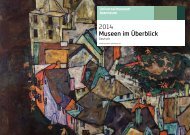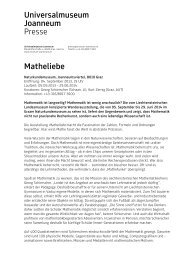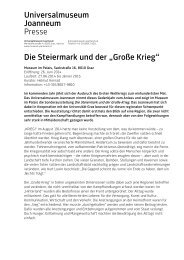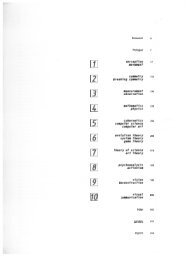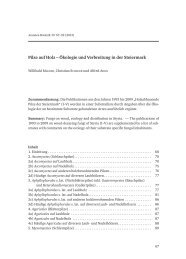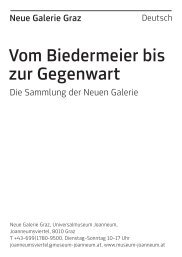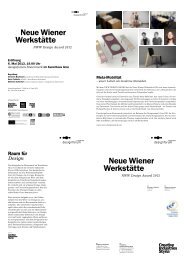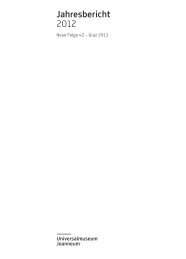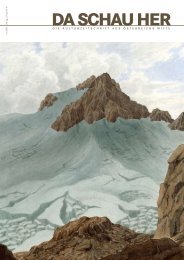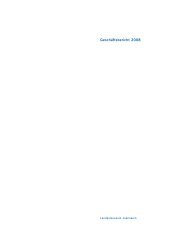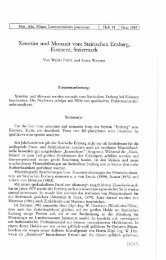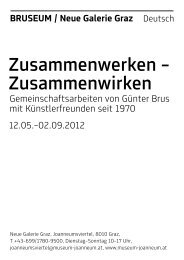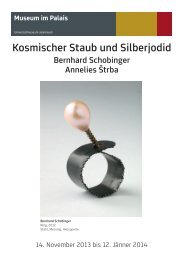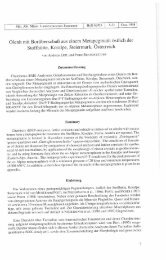Diana Thater gorillagorillagorilla - Universalmuseum Joanneum
Diana Thater gorillagorillagorilla - Universalmuseum Joanneum
Diana Thater gorillagorillagorilla - Universalmuseum Joanneum
Sie wollen auch ein ePaper? Erhöhen Sie die Reichweite Ihrer Titel.
YUMPU macht aus Druck-PDFs automatisch weboptimierte ePaper, die Google liebt.
Mein erster Gorilla von Paul du Chaillu,<br />
Explorations and Adventures in Equatorial<br />
Africa, 1861<br />
My First Gorilla from Paul du Chaillu,<br />
Explorations and Adventures in Equatorial<br />
Africa, 1861<br />
<strong>Diana</strong> <strong>Thater</strong> hat ein Œuvre geschaffen, das sich unserer Um -<br />
welt – Tieren, Pflanzen, dem Weltraum – aus neuen Perspek -<br />
tiven zuwendet, um das Verhältnis von Natur und Kultur zu hinterfragen.<br />
Ihre jüngste Installation <strong>gorillagorillagorilla</strong>, in Auftrag<br />
gegeben vom Kunsthaus Graz und dem Londoner Natural History<br />
Museum, platziert ihre Arbeit in unterschiedlichen architekton ischen<br />
und konzeptionellen Umgebungen: in einer großen Ausstellungsfläche<br />
ohne gerade Wände einerseits, in einem viktorianischen<br />
Terrakotta-Gebäude, das einst eine architektonische Innovation<br />
war, andererseits. Bei der ersten handelt es sich um die Einzelausstell<br />
ung der Künstlerin in Österreich, bei der zweiten um eine<br />
Präsen tation von <strong>Thater</strong>s Installation als Teil einer Gruppenausstellung<br />
im Natural History Museum, im Kontext der Arbeit des<br />
Evolutionstheoretikers Charles Darwin.<br />
Die Ausstellung im Natural History Museum im Jahr 2009 mar -<br />
kiert Darwins 200. Geburtstag, und eine ganze Reihe von Autoren<br />
und Künstlern wurden dazu eingeladen, neue Arbeiten zu schaffen,<br />
die sich mit Darwins Buch The Expression of the Emotions in<br />
Man and Animals (1872)1 auseinandersetzen, das in der deutschen<br />
Übersetzung den Titel Der Ausdruck der Gemüthsbewegungen<br />
bei dem Menschen und den Thieren trägt. Die Arbeiten in der<br />
Ausstellung mit dem Titel After Darwin: Contemporary Expressions<br />
untersuchen die heutige kulturelle Perspektive auf die Verwandtschaft<br />
von Mensch und Tier und das Studium von Gefühlen.<br />
Dieser Essay konfrontiert Charles Darwins Ideen zur Entwicklung<br />
des „Gemüts“ bei Mensch und Tier und seines Ausdrucks mit<br />
<strong>Thater</strong>s Beobachtungen von Flachlandgorillas.<br />
Charles Darwins Ausdruck war eine der ersten Publikationen,<br />
die Fotografien zur Illustration und wissenschaftlichen Beweisführung<br />
verwendete, und erfreute sich bei Erscheinen enormer<br />
Popularität. Mit Verweisen auf Beobachtungen von Tieren im<br />
Londoner Zoo, seine eigenen Kinder, fotografische Studien von<br />
„Wahnsinnigen“ und Untersuchungen der Gesichtsmuskeln des<br />
französischen Physiologen Duchenne de Boulogne spürte Darwin<br />
den Kontinuitäten zwischen den Gefühlszuständen von Tieren<br />
und Menschen nach. Seine Untersuchung basierte auf der<br />
Annahme einer evolutionären Entwicklung, und es waren diese<br />
Ideen, die zu einer umfassenderen Erforschung der Gefühle<br />
von Mensch und Tier führten.<br />
In seiner grundlegenden Studie stellte Darwin das gängige Vorurteil<br />
infrage, dass die mentalen und sozialen Fähigkeiten des Menschen<br />
einen herausragenden Status unter allen Tieren besitzen. Er zeigte<br />
vielmehr, wie sich die sozialen und moralischen Fähigkeiten des<br />
Bergit Arends 42 43<br />
<strong>Diana</strong> <strong>Thater</strong> has created a body of work that<br />
brings new perspectives on our environment –<br />
animals, plants, deep space – to question the<br />
relationship between nature and culture. The new<br />
installation <strong>gorillagorillagorilla</strong>, commissioned by<br />
Kunsthaus Graz and the Natural History Museum<br />
in London, sets her work into different architectural<br />
and conceptual settings: a large space with not<br />
a straight wall in sight, and a Victorian terracotta<br />
building, an architectural innovation at the time.<br />
The first is the artist’s solo exhibition in Austria,<br />
the second is the presentation of <strong>Thater</strong>’s installation<br />
as part of a group exhibition at the Natural<br />
History Museum, contextualised within the work<br />
of evolutionary theorist Charles Darwin.<br />
The exhibition at the Natural History Museum<br />
in 2009 marks the bicentenary of Darwin’s birth,<br />
and a number of writers and artists have been<br />
invited to create new works to explore Darwin’s<br />
book The Expression of the Emotions in Man and<br />
Animals (1872)1. The works in the show, entitled<br />
After Darwin: Contemporary Expressions, will<br />
investigate today’s cultural perspectives on humananimal<br />
kinship, and the study of emotions. This<br />
essay puts into dialogue Charles Darwin’s ideas<br />
on the development of the human and animal<br />
mind and their expressions with <strong>Thater</strong>’s observations<br />
of the lowland gorilla.<br />
Charles Darwin’s Expression, one of the earliest<br />
publications to make use of photography for illustration<br />
and scientific evidence, was hugely popular<br />
in its day. With reference to observations of animals<br />
in London Zoo, his own children, photographic<br />
studies of “lunatics” and research into facial muscles<br />
by French physiologist Duchenne de Boulogne,<br />
Darwin traced the continuities between the emotional<br />
states of animals and humans. He examined<br />
emotions on the basis of evolution, and it was these<br />
thoughts that sparked more widespread research<br />
into human and animal emotions.<br />
Darwin radically challenged preconceptions<br />
that the mental and social capacities of humans<br />
were supreme amongst all animals. Through



